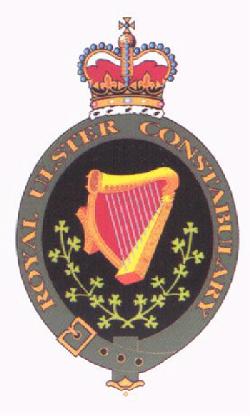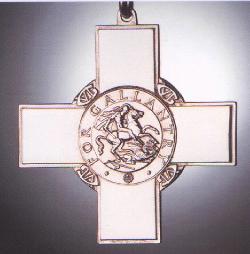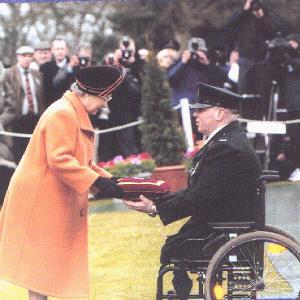ROOTS
| HOME | . |
 The organization known today as the Royal Ulster Constabulary has a very ancient pedigree.
The means of safeguarding the peace in Ireland evolved over many centuries. It was on May 20, 1836, however,
that the British government adopted the law known as the Constabulary (Ireland) Act which organized a national
police force for all of Ireland, then under British rule. This organization, originally known as the Irish Constabulary,
was an important step forward in the evolution of modern law enforcement. Unfortunately, because of the unsettled
political situation that persisted in Ireland, the central government at Dublin Castle used this police agency to enforce
laws and policies that were hugely unpopular with the Irish people. The organization known today as the Royal Ulster Constabulary has a very ancient pedigree.
The means of safeguarding the peace in Ireland evolved over many centuries. It was on May 20, 1836, however,
that the British government adopted the law known as the Constabulary (Ireland) Act which organized a national
police force for all of Ireland, then under British rule. This organization, originally known as the Irish Constabulary,
was an important step forward in the evolution of modern law enforcement. Unfortunately, because of the unsettled
political situation that persisted in Ireland, the central government at Dublin Castle used this police agency to enforce
laws and policies that were hugely unpopular with the Irish people. The central government was happy with its constabulary and eventually granted it the
privilege of being called the Royal Irish Constabulary. As a consequence of its association with evictions of Irish
people from their homes and lands and other hated policies, at the time of partition in 1922, the new Irish state
disbanded the RIC and organized a totally new police force known as the Garda Siochana. In the six counties of the
North, which remained under British rule, the remnants of the RIC were organized into the Royal Ulster Constabulary. The central government was happy with its constabulary and eventually granted it the
privilege of being called the Royal Irish Constabulary. As a consequence of its association with evictions of Irish
people from their homes and lands and other hated policies, at the time of partition in 1922, the new Irish state
disbanded the RIC and organized a totally new police force known as the Garda Siochana. In the six counties of the
North, which remained under British rule, the remnants of the RIC were organized into the Royal Ulster Constabulary.
 The RUC is and always has been a legitimate and highly professional law enforcement
agency. But having, as it has, to operate in a divided community in which much of the populace does not accept its
authority and in a province in which local government has been supplanted by direct rule from London for some thirty
years now, it has had big problems. Moreover, the violence known as the Troubles has hit the rank and file of the RUC
very hard indeed. Over the past thirty years, some 302 members of the force have died as victims of sectarian violence.
Thousands more have been injured, many so seriously as to be permanently disabled. Whatever one thinks of the
problem of governance in Northern Ireland, these men and women and their families deserve our respect
and sympathy. The RUC is and always has been a legitimate and highly professional law enforcement
agency. But having, as it has, to operate in a divided community in which much of the populace does not accept its
authority and in a province in which local government has been supplanted by direct rule from London for some thirty
years now, it has had big problems. Moreover, the violence known as the Troubles has hit the rank and file of the RUC
very hard indeed. Over the past thirty years, some 302 members of the force have died as victims of sectarian violence.
Thousands more have been injured, many so seriously as to be permanently disabled. Whatever one thinks of the
problem of governance in Northern Ireland, these men and women and their families deserve our respect
and sympathy. On November 23, 1999, Her Majesty the Queen bestowed upon the Royal Ulster
Constabulary the highest award that the British government has created for valor that may be given to a civilian.
It is called the George Cross. Chief Constable Sir Ronnie Flanagan accepted it on behalf of the men and women
of the RUC at a ceremony at Buckingham Palace. Said Her Majesty: "I admire your determination to maintain the
rule of law, and to provide a police service for all the people during some of the most difficult times in the history
of this Province. A terrible price has been paid for this brave and resolute stand." On November 23, 1999, Her Majesty the Queen bestowed upon the Royal Ulster
Constabulary the highest award that the British government has created for valor that may be given to a civilian.
It is called the George Cross. Chief Constable Sir Ronnie Flanagan accepted it on behalf of the men and women
of the RUC at a ceremony at Buckingham Palace. Said Her Majesty: "I admire your determination to maintain the
rule of law, and to provide a police service for all the people during some of the most difficult times in the history
of this Province. A terrible price has been paid for this brave and resolute stand."
 A terrible price indeed. Now, in addition to everything else, this organization is going
through enormous internal change in accordance with the terms of the Good Friday Peace Agreement and the
recommendations of the Patten Report. A terrible price indeed. Now, in addition to everything else, this organization is going
through enormous internal change in accordance with the terms of the Good Friday Peace Agreement and the
recommendations of the Patten Report.
 It happens that over a century ago, a man named George Stephens served in the
Royal Irish Constabulary. He was my great-grandfather. I don't know much about him except that he and his family
are buried in a place called Stradbally, County Waterford under a gravestone on which is proudly recorded his
RIC affiliation. It must have been difficult for him. He worked as a policeman for a government that created an
environment that prompted almost all of his many children to leave Ireland for good. But the little people like
George Stephens don't call the shots. It happens that over a century ago, a man named George Stephens served in the
Royal Irish Constabulary. He was my great-grandfather. I don't know much about him except that he and his family
are buried in a place called Stradbally, County Waterford under a gravestone on which is proudly recorded his
RIC affiliation. It must have been difficult for him. He worked as a policeman for a government that created an
environment that prompted almost all of his many children to leave Ireland for good. But the little people like
George Stephens don't call the shots. Today, I consider the RUC to be the successor to my great-grandfather's old outfit and
I care what happens to it under the Patten Report and under the stewardship of Oversight Commissioner Tom
Constantine. That latter fact makes me optimistic, to use one of Professor Constantine's favorite words. Today, I consider the RUC to be the successor to my great-grandfather's old outfit and
I care what happens to it under the Patten Report and under the stewardship of Oversight Commissioner Tom
Constantine. That latter fact makes me optimistic, to use one of Professor Constantine's favorite words. At any rate, there has been a traveling exhibition on the accomplishments and history
of the Royal Ulster Constabulary. It has been shown already at the Parliament in Westminster and at the Dail in
Dublin. It recently opened at Stormont, where the Northern Ireland Assembly sits. We aim to bring it to the
United States, specifically to Albany where Professor Constantine is on the faculty of our State University. We
have asked a prominent Member of the Northern Ireland Assembly for his help in doing so. At any rate, there has been a traveling exhibition on the accomplishments and history
of the Royal Ulster Constabulary. It has been shown already at the Parliament in Westminster and at the Dail in
Dublin. It recently opened at Stormont, where the Northern Ireland Assembly sits. We aim to bring it to the
United States, specifically to Albany where Professor Constantine is on the faculty of our State University. We
have asked a prominent Member of the Northern Ireland Assembly for his help in doing so.
7 September 2000 The Honourable Sean Neeson The Assembly Parliament Buildings Stormont, Belfast BT4 3XX Dear Mr. Neeson:  I compliment you and your colleague Jane Morrice for hosting the opening reception
for the Royal Ulster Constabulary historical exhibit at Stormont. It was particularly heartwarming to learn of your
solicitousness toward the families of fallen and disabled officers. Having been involved over the past decade in the
creation of a number of programs and initiatives to aid and comfort families of police officers killed or disabled in the
line of duty here in New York and elsewhere, I am well aware of the importance of the special continuity and connection
between survivors and disabled officers and the police organizations they served. Your kindness and sensitivity are
especially to be appreciated during this difficult time of transition for the Royal Ulster Constabulary and its extended
family. I compliment you and your colleague Jane Morrice for hosting the opening reception
for the Royal Ulster Constabulary historical exhibit at Stormont. It was particularly heartwarming to learn of your
solicitousness toward the families of fallen and disabled officers. Having been involved over the past decade in the
creation of a number of programs and initiatives to aid and comfort families of police officers killed or disabled in the
line of duty here in New York and elsewhere, I am well aware of the importance of the special continuity and connection
between survivors and disabled officers and the police organizations they served. Your kindness and sensitivity are
especially to be appreciated during this difficult time of transition for the Royal Ulster Constabulary and its extended
family. The Irish Times this morning reported Chief Constable Sir Ronnie
Flanagan's words spoken at this event: "I want to see this transformation as the continuation of a journey rather than
a new beginning." I started tagging along on this journey recently when my friend Professor Tom Constantine accepted
the call to serve as Oversight Commissioner for the implementation of the Patten Commission reforms. In the course
of learning more about the Professor's task and the agency with which he is working, I came to a new appreciation of
my own family's connection to that historic journey about which the Chief Constable spoke so eloquently. The Irish Times this morning reported Chief Constable Sir Ronnie
Flanagan's words spoken at this event: "I want to see this transformation as the continuation of a journey rather than
a new beginning." I started tagging along on this journey recently when my friend Professor Tom Constantine accepted
the call to serve as Oversight Commissioner for the implementation of the Patten Commission reforms. In the course
of learning more about the Professor's task and the agency with which he is working, I came to a new appreciation of
my own family's connection to that historic journey about which the Chief Constable spoke so eloquently. My great-grandfather George Stephens of Stradbally, County Waterford served as a
member of the Royal Irish Constabulary at the end of the 19th Century. He and his family were so proud of that
association that they all lie under a gravestone on which his affiliation is recorded. I consider the RUC to be the
contemporary successor to my great-grandfather's old outfit and the Police Service of Northern Ireland to be part
of its future. I also consider the RIC to be the great-grandfather of all the great modern police agencies with which
I have been associated. My great-grandfather George Stephens of Stradbally, County Waterford served as a
member of the Royal Irish Constabulary at the end of the 19th Century. He and his family were so proud of that
association that they all lie under a gravestone on which his affiliation is recorded. I consider the RUC to be the
contemporary successor to my great-grandfather's old outfit and the Police Service of Northern Ireland to be part
of its future. I also consider the RIC to be the great-grandfather of all the great modern police agencies with which
I have been associated. The common thread running through all of this history is the dedication and bravery
of the men and women who serve and the families who love and support them. Surprisingly, this history, especially
that of the RUC, is not well known or appreciated in the United States. We should really do something to turn that
around. It wouldn't be that difficult and this is how I'd suggest we do it. The common thread running through all of this history is the dedication and bravery
of the men and women who serve and the families who love and support them. Surprisingly, this history, especially
that of the RUC, is not well known or appreciated in the United States. We should really do something to turn that
around. It wouldn't be that difficult and this is how I'd suggest we do it. Here in New York, we are so proud of Professor Constantine and his contribution to
this noble cause that words can scarce express it. I would suggest that in his honor whoever makes decisions
about these things consider making the next venue for the RUC exhibition to be here in our Capital District where
the Professor serves on the distinguished faculty of the State University of New York. Perhaps you would be so
kind as to direct this suggestion to the appropriate authority. Here in New York, we are so proud of Professor Constantine and his contribution to
this noble cause that words can scarce express it. I would suggest that in his honor whoever makes decisions
about these things consider making the next venue for the RUC exhibition to be here in our Capital District where
the Professor serves on the distinguished faculty of the State University of New York. Perhaps you would be so
kind as to direct this suggestion to the appropriate authority.Sincerely, TERRY O'NEILL Albany, New York  Questions? E-mail Us! CONSTANTINE'S CIRCUS, INC. PO Box 7223 Capitol Station Albany, NY 12224-0223 518-465-4413 518-465-3200 FAX |

